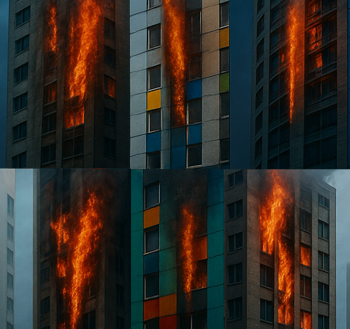Main author
Multiple Author ArticleBREEAM Speculative floor & ceiling finishes
Contents |
[edit] Aim and benefits
This credit is designed to minimise the waste involved in installing undesirable floor finishes in office spaces.
It is common that when a tenant moves in to an office, they replace floor and/or ceiling finishes to match their corporate branding, or corporate tastes. If floor/ceiling finishes have already been installed by the developer, frequently these will be removed and disposed of. By reducing the quantity of installed floor finishes, or agreeing with the occupant in advance, this waste can be near eliminated.
[edit] When to consider
At detailed design stage, prior to RIBA stage 4 freeze when the finishes and fit-out elements are specified.
This credit is not applicable to shell only projects.
[edit] Step by step guidance
The building is occupied by a specific occupant - the occupant shall select/agree the floor and ceiling finishes. The agreement must be recorded and documented for inclusion in the BREEAM evidence documents
The building is tenanted - Floor and ceiling finishes shall not be specified unless the future tenants/occupants are known and agreed on the fit-out finishes - as above, the agreement documents to be provided for inclusion in evidence documents
If the future occupants are unknown, finishes can be installed in the show areas only - see below for the limitation on show areas
[edit] Questions to ask while seeking compliance
Is it a show area, if so to award the credit it must be less than 25% of the net lettable floor area. Or where the future occupant is not known, and finishes are being installed to more than 25%, will there be a clause included within the lease agreement to ensure that the tenant can not remove the finishes unless necessary due to wear and tear?
Is the future occupant known or not? Have they agreed to the finishes specified?
[edit] Tools and resources
BREEAM UK New Construction 2014 SD5076 – Issue: 5.0 - WST 04
Knowledge Base Articles - UK New Construction 2014 - WST 04
[edit] Tips and best practice
tbc
[edit] Typical evidence
Design Stage
For tenanted areas where the future tenant is not known: design drawings should be provided to show floor and ceiling finishes are to be installed to a show area only (no more than 25% of the lettable floor area) or that no finishes are to be installed. Alternatively, a copy of the relevant section/clauses of the building specification or contract could be provided.
Where the future tenant is not known, and the developer wishes to install finishes as part of their scope of work, they must provide a formal letter to confirm that there will be a clause within their lease agreement to ensure that finishes will not to be removed or replaced by tenants unless required due to wear and tear or damage.
Where the future occupant is known, then they should provide written confirmation that they have specified or agreed to the finishes that are to be installed.
Post Construction
As design stage + BREEAM assessor’s site inspection report and photographic evidence to show the ceiling/floor finishes that have been installed. Copy of tenancy agreement, where finishes are to be installed and future occupant is not known.
[edit] Applicable Schemes
The guidelines collated in this ISD aim to support sustainable best practice in the topic described. This issue may apply in multiple BREEAM schemes covering different stages in the life of a building, different building types and different year versions. Some content may be generic but scheme nuances should also be taken into account. Refer to the comments below and related articles to this one to understand these nuances. See this document for further guidelines.
- UK New Construction 2014
This document was originally created on 17/01/18 in a collaboration of the following BREEAM Professionals: Jane Morning, Cat Clarkson, Azita Dezfouli and Tom Abbott
BRE Global does not endorse any of the content posted and use of the content will not guarantee the meeting of certification criteria.
--Multiple Author Article 22:13, 21 Apr 2018 (BST)
Featured articles and news
Government consultations for the summer of 2025
A year of Labour, past and present consultations on the environment, the built environment, training and tax.
CMA competitiveness probe of major housing developers
100 million affordable housing contributions committed with further consultation published.
Homes England supports Greencore Homes
42 new build affordable sustainable homes in Oxfordshire.
Zero carbon social housing: unlocking brownfield potential
Seven ZEDpod strategies for brownfield housing success.
CIOB report; a blueprint for SDGs and the built environment
Pairing the Sustainable Development Goals with projects.
Types, tests, standards and fires relating to external cladding
Brief descriptions with an extensive list of fires for review.
Latest Build UK Building Safety Regime explainer published
Key elements in one short, now updated document.
UKGBC launch the UK Climate Resilience Roadmap
First guidance of its kind on direct climate impacts for the built environment and how it can adapt.
CLC Health, Safety and Wellbeing Strategy 2025
Launched by the Minister for Industry to look at fatalities on site, improving mental health and other issues.
One of the most impressive Victorian architects. Book review.
Common Assessment Standard now with building safety
New CAS update now includes mandatory building safety questions.
RTPI leader to become new CIOB Chief Executive Officer
Dr Victoria Hills MRTPI, FICE to take over after Caroline Gumble’s departure.
Social and affordable housing, a long term plan for delivery
The “Delivering a Decade of Renewal for Social and Affordable Housing” strategy sets out future path.
A change to adoptive architecture
Effects of global weather warming on architectural detailing, material choice and human interaction.
The proposed publicly owned and backed subsidiary of Homes England, to facilitate new homes.
How big is the problem and what can we do to mitigate the effects?
Overheating guidance and tools for building designers
A number of cool guides to help with the heat.
The UK's Modern Industrial Strategy: A 10 year plan
Previous consultation criticism, current key elements and general support with some persisting reservations.
Building Safety Regulator reforms
New roles, new staff and a new fast track service pave the way for a single construction regulator.

























